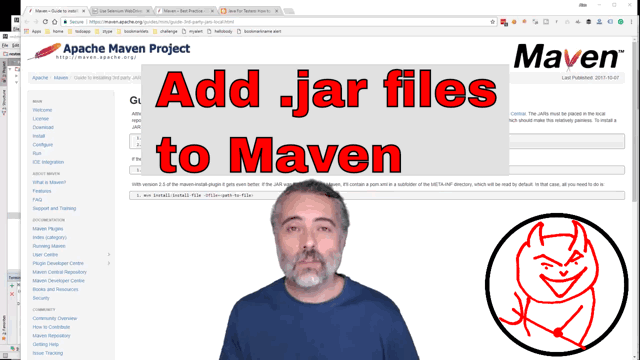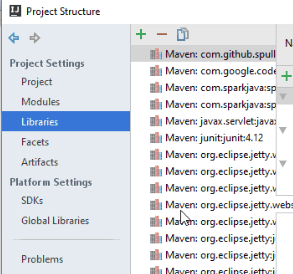TL;DR Hack - add as a library in IntelliJ project. Tactic - add as system scope in maven. Tactic/Strategic - install locally to .m2. Strategic - use a repository management tool, publish to maven central

Sometimes you want to work with a jar file that isn’t hosted in maven central.
It might be a 3rd party jar, it might be one that you have written.
Regardless.
You have a lot of options for this. The approaches that I have used:
- add
.jarfiles as an IntelliJ project dependency - install it locally to your
.m2repository - add it to your project as a system scoped file
- use a repository management tool: like Nexus or Archiva
- publish the dependency to maven central
Quick Hack - add jar as an IntelliJ project dependency
For very quick hacks, add the .jar as an IntelliJ project dependency and bypass maven.


I demonstrate this in my free Java Desktop Application Technical Testing and you can read a blog post containing this information.
This is a very tactical approach:
- it doesn’t scale
- it doesn’t help you work with other people
- it isn’t very good for CI or version control
But it might help you get your immediate work done:
- experiment
- try something out
- get a task completed
And then adopt one of the following approaches if it works.
Add to project as system scoped file
As a short term tactic, I have also added the .jar as a system scoped file.
I did this in the past when working with a ‘bug fix’ version of Selenium WebDriver that had not yet propagated through to maven central, but which was available for download.
<dependency>
<groupId>selenium_2_53_1</groupId>
<artifactId>com.seleniumhq.selenium_2_53_1 </artifactId>
<version>2.53.1</version>
<scope>system</scope>
<systemPath>
C:/Users/Alan/Downloads/selenium-2.53.1/selenium-server-standalone-2.53.1.jar
</systemPath>
</dependency>
This can be a useful tactic, but I don’t think it really scales strategically.
Install .jar locally to your .m2 repository
To have the .jar available as a dependency that I can bring in using a normal maven include, I can install the .jar locally to my .m2 directory and repository.
This is explained on the maven website:
And I use this approach at the moment when working with my RestMud game engine
I have split my game into multiple projects:
- game engine (which is now open source on github)
- RestMud game, Web Server and REST API
- https://github.com/eviltester/restmud/tree/master/src
I have not released the game engine to Maven central, but the code is available on github, as is a release .jar file.
I can build a snapshot .jar locally for my current work.
Install it into my .m2 folder
mvn install:install-file \
-Dfile=target/restmud-engine-1.4-SNAPSHOT-jar-with-dependencies.jar \
-DpomFile=pom.xml
If I didn’t have the pom.xml file, I could still do this, I just add the details from the pom.xml into my command line:
mvn install:install-file \
-Dfile=target/restmud-engine-1.4-SNAPSHOT-jar-with-dependencies.jar \
-DgroupId=uk.co.compendiumdev \
-DartifactId=restmud-engine \
-Dversion=1.4-SNAPSHOT \
-Dpackaging=jar
And if I want the source code jar to be associated with the .jar (which I usually do) then I add the following argument to the command line:
-Dsources=target/restmud-engine-1.4-SNAPSHOT-sources.jar
This allows me to keep the pom.xmlof my projects which use the .jar to remain as though the .jar was on a repository manager or in maven central.
I think this is a good tactical approach, that supports a longer term strategic development of your development and automated execution approach.
Use a repository management tool
You could install a dependency management tool like nexus or Archiva.
Then your .jar files are installed into this repository which is accessible by your team, and CI process, and not just your local development machine.
Maven docs on Repositories:
You have to:
- install the dependency management tool
- configure the
pom.xmlto have a<repositories>section and point to your dependency management tool
You’ll probably want to evaluate which of the repository management tools works best for you and your environment.
This is a much more strategic approach and is good for team work and continuous integration processes.
Publish to Maven Central
This is probably the most strategic long term approach, but requires you to make your work public.
All of the other approaches mentioned allow you to keep your work to yourself.
It is quite a long process, so I won’t describe it here, but I have a full write up on this blog post.
https://www.eviltester.com/2016/10/how-to-create-and-release-jar-to-maven.html
Summary
- The ultimate short term hack - add it as a dependency in your IDE
- For quick hacks - add it as
systemscoped maven dependency - For personal work, or moving towards a strategic approach, install locally to
.m2 - For longer term tactical work as a team, use a repository manager
- For strategic open source work, release to maven central
Useful Links
Hack Tactic: Adding .jar to IntelliJ
Install .jar into your local .m2 folder or as System scope
- https://maven.apache.org/guides/mini/guide-3rd-party-jars-local.html
- https://stackoverflow.com/questions/4955635/how-to-add-local-jar-files-to-a-maven-project
- http://roufid.com/3-ways-to-add-local-jar-to-maven-project
Using a Repository Manager
Releasing your Jar to maven central
Comments
On DZone, Florien Enner mentioned the approach he likes to use:
My personal favorite is to install the jar into a local folder (e.g. a ’lib’ folder next to ‘src’) that can be added as an external repo in Maven. That way you can just check it into version control and don’t need to setup a full repo or require every computer to install a jar into the m2 repo. You can do that by specifying e.g. -DlocalRepositoryPath="./" See e.g. https://stackoverflow.com/q/3642023







